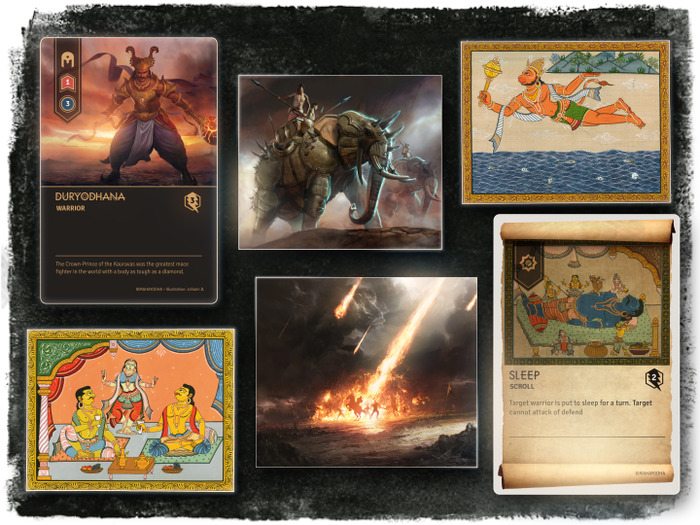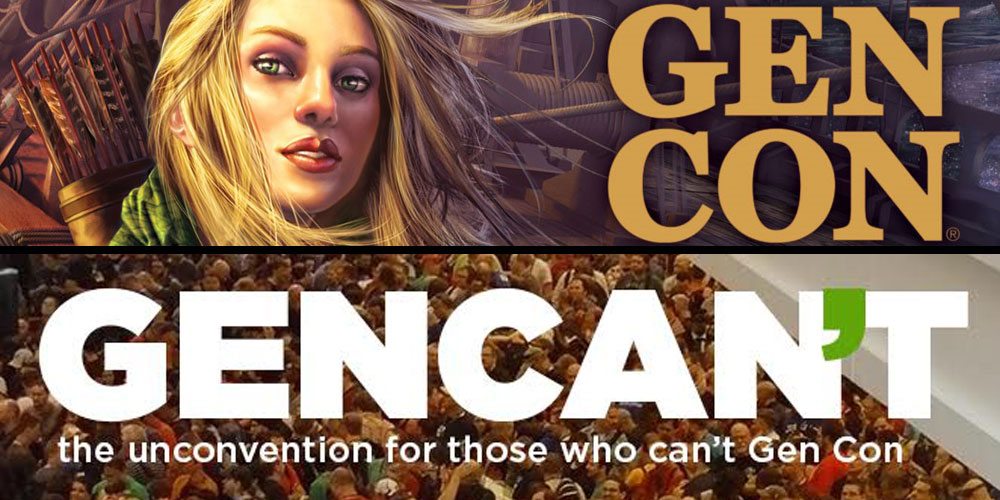Table for Two is a series focusing on two-player board games. Today’s game is Maha Yodha, which was inspired by Indian mythology.
In Sanskrit, Maha Yodha means “the greatest warrior.” That’s your goal in this two-player card game: to defeat your opponent by commanding warriors, weapons, and scrolls. Maha Yodha is based on Hindu mythology, which, as it turns out, makes great subject matter for fantastic artwork. It just launched on Kickstarter today.
At a glance: Maha Yodha is for two players, ages 10 and up, and takes about 20 minutes to play. The pledge level for a copy of the game is $20 (or $35 for the game plus the expansion). Based on the gameplay and subject matter, I think the age recommendation is about right. Younger kids who are familiar with card games like Magic or Pokemon would probably be able to handle the mechanics, as long as you’re okay with the fantasy artwork and sometimes-violent subject matter. (Note that Maha Yodha is not a CCG, but the mechanics share some similarities.)

Components
Two decks of cards: Adityas (white deck) and Asuras (black deck), each 52 cards (at least in the prototype form). Additional cards will be available as expansion packs.
The copy I played was a prototype, so it was a mix of completed artwork and placeholder artwork. The game uses a combination of modern fantasy artwork and traditionally styled Indian pattachitra art. There are only a few types of icons, so overall the cards are pretty easy to understand, though I recommended to the game designer that they make the icons larger so they’re more visible from across the table.
The artwork for the game takes various characters and items from Hindu tradition and reimagines them in a high fantasy style.
How to Play
The object of the game is to reduce your opponent’s life to zero. Each player starts with 20 life (you’ll need some counters or pen and paper to track this).
Each player takes one of the decks and shuffles it. The first player gets to draw six cards for their first hand, but cannot attack. The second player draws five and may attack on their first turn.

There are three types of cards: Warriors, which provide some amount of attack and/or defense; Weapons, which must be played on a Warrior; and Scrolls, which have various effects. Each card requires a certain amount of Valour to play—you start each turn with 5 Valour to spend, and any unspent Valour is forfeited. Some card combinations provide you with more Valour: for instance, most weapons will give +1 Valour if equipped to the correct warrior.
On your turn, first you pick up any Weapons or Warriors you have on the battlefield in front of you. Any Scrolls of yours on the battlefield are discarded. Next, you may discard any number of cards in your hand, and then draw back up to five cards. Finally, you spend your 5 Valour to play cards from your hand to the battlefield.
If you play any Warriors on your turn, you must attack your opponent. You add up your total attack value from all of your cards, and compare that to the total defense of your opponent. Whoever has the lower amount loses life points equal to the difference. You don’t have to play any warriors on your turn, of course, but if you have no defense then your opponent will be able to attack you on their turn.
That’s basically it. You take turns until one player runs out of life points.
The Verdict
Despite the very simple-seeming rules, Maha Yodha does offer pretty nice strategic depth, which surprised me the first time I played it. Managing your hand of five cards is really important: you might have a warrior-weapon combo that you really like, but if you keep picking those up and putting them into your hand each turn, then that means you won’t be drawing as many cards. Also, 5 Valour is not a lot—most warriors take 2 or 3 to play, and weapons are 1 or 2, so the scrolls come in handy to throw in other effects.
Ah, the scrolls. These are where the game really gets interesting. Most of the warriors and weapons are simply some combination of attack and defense—the white deck has a couple of warriors that let you choose between additional attack or defense—but otherwise there’s nothing particularly special about any given one, other than that weapons will combo with one particular hero. The scrolls, however, have all sorts of wild abilities. Some let you pick up cards from your opponent’s battlefield. Some do damage, ignoring defense. Many of them let you affect your opponent: decreasing their attack or defense, reducing their hand size for a turn, reflecting damage back to them, and so forth.
However, the power of the scrolls is directly tied to their cost. The most powerful scrolls will cost all (or nearly all) of your Valour, potentially leaving you with no defense whatsoever on your opponent’s next turn. And since discarding all of your cards and drawing five new ones is always an option, having no warriors can make you a sitting duck.
The other interesting part is the fact that your battlefield determines both your attack on your turn and your defense on your opponent’s turn. In any given turn, you usually won’t be able to play a whole lot of both, so you’ll have to choose. If you play a high defense but low attack, then you may take damage on your turn because your attack cannot overcome your opponent’s defense. But then the same may be true for your opponent on their next turn. On the other hand, playing offensively means that you leave yourself open to attack as well.
Because of the way damage is dealt, the game plays pretty quickly, and it’s likely that you won’t run through your entire deck unless you’re constantly discarding everything to draw new cards. I like the fast pace, and usually I end up playing again, swapping decks with the other player so we each get a taste of both types.
The two decks have a lot of the same scrolls, but different sets of warriors and weapons. I haven’t played enough to really get a sense for how that affects strategy and tactics, other than that they differ slightly. I also don’t know enough about Hinduism to understand what the two decks represent.

There are two weaknesses that I spotted with the game: one is the rulebook, at least the prototype version. The prototype rulebook was very brief and didn’t explain many of the special circumstances that would arise from particular cards. While I’m a fan of short rules, I think the game would benefit greatly from a list of cards explaining exactly what they mean, so that players don’t have to make their own judgment calls about when an effect takes place or how to resolve specific scrolls. My understanding was that the rulebook will get a significant overhaul, but so far the version available on the Kickstarter page is still pretty slim and lacks the details about cards. I’ve been told that the game developers are having an independent rulebook reviewer work on it, so it’s worth checking back to see if that gets updated later in the campaign.
Some of the warriors and weapons have flavor text on them telling a little more about the background, but these are also very short bits. Since this is the first game I’ve ever played that has an Indian theme, I’d love to see that get fleshed out a bit more, too—I would guess there are many gamers who (like me) know very little about Hindu mythology and wouldn’t mind more details about the characters and items on the cards.
The other weakness is that sometimes you might get a good combination of warrior/weapon cards, and since you can pick them up each turn, you can just keep playing those. The counter to this is that the other player may have scrolls that can either discard or steal one of your cards to break the chain, but they’ll have to discard and hope to draw something useful—the longer they wait to do so, the more you can continue to use the same combination. It hasn’t happened often, but when it does it feels less exciting—you’re not making any significant choices on those turns; you’re just repeating your last turn. Fortunately, it doesn’t happen often (unless the other player lets you).
A quick word about the game’s creators: the game concept is by Sagar Shankar, with gameplay design by Chandan Mohanty. Graphics design is by Pravjal Mendon. I don’t have artist names, though I imagine there’s more than one. Saar Shai, the creator of the Kickstarter hit The Agents, is a consulting designer and is working with the team on design and fulfillment, so I feel comfortable knowing that the game will get printed and delivered if the funding goal is reached.
Overall, Maha Yodha is an excellent two-player game. It breaks new ground with the theme, and it is easy to learn. Despite sharing some similarities to other card-based battle games, the hand management has some distinct differences that keep it from feeling like a clone. Most turns I felt like I had some careful decisions to make about what to keep or discard, how to spend my Valour, whether to attack or defend. If you’re looking for a two-player card game, Maha Yodha is worth trying.
For more information, visit the Maha Yodha Kickstarter page.
Disclosure: GeekDad received a demo prototype for review purposes.





Thanks Jonathan! Thanks for your review of Maha Yodha. Loved reading it. We are on the rulebook and should have a more comprehensive version out- in the next couple of days. We love the idea of giving a quick summary of the cards effects in more detail in the rulebook. However, if we hit our stretch goals will introduce newer card and mechanics. So the final version may be 45-60 days away.
A few of our play testers and reviewers have told us that gold on white isnt working. We are a few hours away from releasing a new card design. It will be updated soon on BGG and our FB & KS campaign page.
Sagar & I are trivia fanatics. Most people who have played with the cards would like to see more trivia as the flavour text. We wanted to hear the feedback from our users before we tweaked the rest of the trivia.
Once again, many thanks for your time & efforts to review our game. Looking forward to your continued counsel & support for Maha Yodha
Vijaye Bhava!
Chandan
ps Vijaye Bhava- It is a blessing given by elders to a warrior going out to battle. Translated, it means, may vicotry be yours 🙂